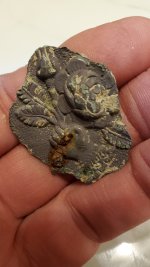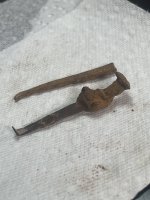Highmountain
Hero Member
The only surviving eye-witness account of Mexico-area gold and associated topics from the time of the arrival of the Spaniards through early-post-conquest comes from Bernal Diaz del Castillo, so far as I've been able to determine.
He always noted quality of what came into the Spaniard hands from one of the tribes, and he never mentioned anything high-quality until the issue was Aztec gold. He told of being in the presence of a lot of what he described as 'good quality' gold while Montezuma was a prisoner. He gave a vivid account of the abandonment of it before the fight across the causeway, other than the amount they could carry.
The tonnage the Spaniards saw and touched in the palace were never mentioned as having been recovered.
Somewhere back there a legend began of Monetzuma instructing the Aztecs to hide their gold began and persisted through the centuries. The story of four columns of 1000 people each carrying the hoards north and hiding it has cropped up time-to-time as frequently as the places it's thought to be located.
Today it's still out there being theorized in the same general locations it always was, though Utah's probably hottest at the moment. But I've never been able to find out when and where that story began, nor even where the story of Montezuma's instructions for the Aztecs to hide it got started.
One of the arguments the legend is false has always rested on the premise that 4000 people knowing a secret makes it a lead-pipe cinch it will be told and remembered. The fact the locations haven't shown themselves in tribal legends somewhere almost certainly means, either the gold didn't come north, or the people carrying it didn't live long enough after having done so to spread the tale of the journey and the whereabouts of the hiding places.
Judging from the various scratchings on rocks and other evidence found in New Mexico, Arizona and Utah, I'm inclined to think hoards did come north. The logistics for those treks must have been a nightmare for each of the columns and they must have manifested themselves in countless vessels for carrying food and water to keep the carriers alive long enough to reach the destination.
The Aztecs were nothing if not a bloodthirsty lot. It's easy enough to imagine a final bloodbath to make certain none who were lowly enough to be carriers survived to carry tales of the location. But who'd be there to do the work of burying them and all those vessels they used to carry their own food? What's less believable is that those who probably killed them dirtied their hands with anything but human blood.
So after stacking assertion atop assertion it seems to me anyone searching for Aztec gold might be well served by looking for the remains of a thousand large vessels, besides drawings on cliff-walls. That, and the surrounding soil dominated by thousands of human teeth. Probably the rest of the bone fragments are gone, but teeth last a surprisingly long while.
Human teeth and possibly metal pots. Those two terrain features ought to assure a third is somewhere nearby.
J
Edit: Diaz also tells of what the enemies of the Aztecs had to say about where they came from and when they arrived in the Valley of Mexico. Not more than a century before the arrival of the Spaniards, migrated in from somewhere in the north by the thousands and tens of thousands from somewhere called Aztl'an [Aztl'an mightn't be Diaz]. Generally accepted among linguists these days to mean, either, place of 7 caves, or 'whiteness' place [because of the accented last syllable, changing it from the earlier, 'place of herons' interpretation]. But judging from the fact the Aztecs had a lot of good quality gold and their neighbors evidently didn't, it might be safe to assume there was a lot in their place of origin in the north. In fact, that might well be one of the places they returned it to.
He always noted quality of what came into the Spaniard hands from one of the tribes, and he never mentioned anything high-quality until the issue was Aztec gold. He told of being in the presence of a lot of what he described as 'good quality' gold while Montezuma was a prisoner. He gave a vivid account of the abandonment of it before the fight across the causeway, other than the amount they could carry.
The tonnage the Spaniards saw and touched in the palace were never mentioned as having been recovered.
Somewhere back there a legend began of Monetzuma instructing the Aztecs to hide their gold began and persisted through the centuries. The story of four columns of 1000 people each carrying the hoards north and hiding it has cropped up time-to-time as frequently as the places it's thought to be located.
Today it's still out there being theorized in the same general locations it always was, though Utah's probably hottest at the moment. But I've never been able to find out when and where that story began, nor even where the story of Montezuma's instructions for the Aztecs to hide it got started.
One of the arguments the legend is false has always rested on the premise that 4000 people knowing a secret makes it a lead-pipe cinch it will be told and remembered. The fact the locations haven't shown themselves in tribal legends somewhere almost certainly means, either the gold didn't come north, or the people carrying it didn't live long enough after having done so to spread the tale of the journey and the whereabouts of the hiding places.
Judging from the various scratchings on rocks and other evidence found in New Mexico, Arizona and Utah, I'm inclined to think hoards did come north. The logistics for those treks must have been a nightmare for each of the columns and they must have manifested themselves in countless vessels for carrying food and water to keep the carriers alive long enough to reach the destination.
The Aztecs were nothing if not a bloodthirsty lot. It's easy enough to imagine a final bloodbath to make certain none who were lowly enough to be carriers survived to carry tales of the location. But who'd be there to do the work of burying them and all those vessels they used to carry their own food? What's less believable is that those who probably killed them dirtied their hands with anything but human blood.
So after stacking assertion atop assertion it seems to me anyone searching for Aztec gold might be well served by looking for the remains of a thousand large vessels, besides drawings on cliff-walls. That, and the surrounding soil dominated by thousands of human teeth. Probably the rest of the bone fragments are gone, but teeth last a surprisingly long while.
Human teeth and possibly metal pots. Those two terrain features ought to assure a third is somewhere nearby.
J
Edit: Diaz also tells of what the enemies of the Aztecs had to say about where they came from and when they arrived in the Valley of Mexico. Not more than a century before the arrival of the Spaniards, migrated in from somewhere in the north by the thousands and tens of thousands from somewhere called Aztl'an [Aztl'an mightn't be Diaz]. Generally accepted among linguists these days to mean, either, place of 7 caves, or 'whiteness' place [because of the accented last syllable, changing it from the earlier, 'place of herons' interpretation]. But judging from the fact the Aztecs had a lot of good quality gold and their neighbors evidently didn't, it might be safe to assume there was a lot in their place of origin in the north. In fact, that might well be one of the places they returned it to.


 ??the spanish
??the spanish 


